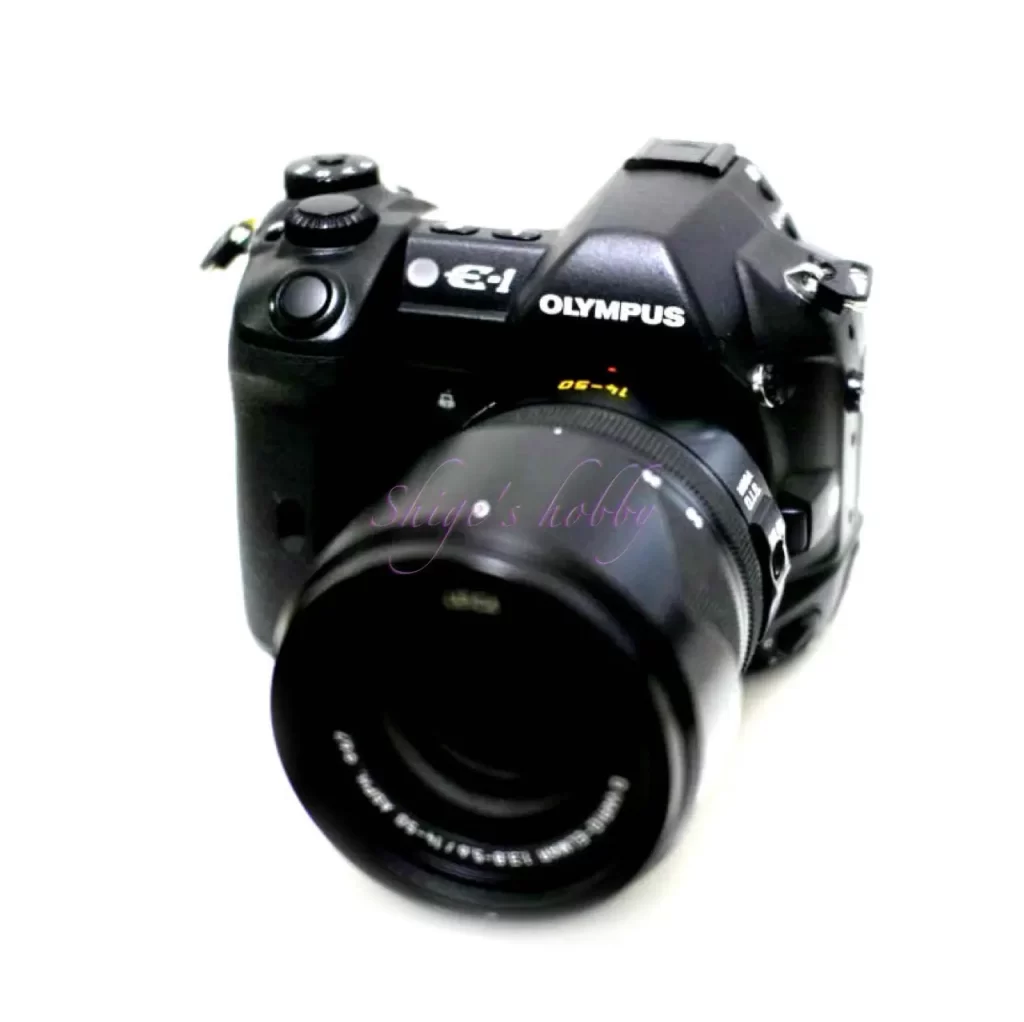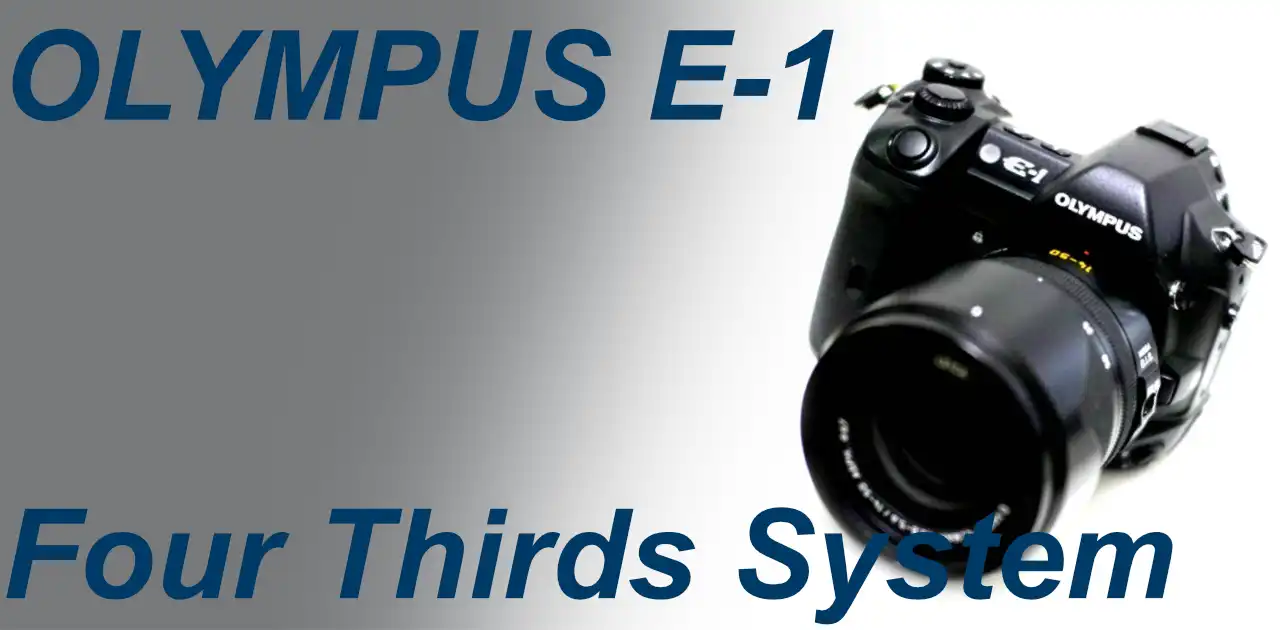A review and photo examples of the Olympus E-1 digital SLR camera.
- Please see the disclaimer regarding advertising here.
- Italicized links in the text are advertisement links that take you to other sites.
目次
Gallery
The lenses used to take the example images were the Olympus Zuiko Digital ED 50-200mm F2.8-3.5 and the EICA D VARIO-ELMAR 14-50mm.
Review

1.Overview
The E-1 is a Four Thirds mount SLR camera released by Olympus (now OM-SYSTEMS) in 2003.
Its main specifications are a 5 megapixel Kodak sensor, 3 frames per second, up to 12 shots, and CompactFlash recording media.
The 5 megapixel sensor can record images at a maximum resolution of 2560 x 1920 pixels.
2.Usability
As the first Four Thirds mount camera, it has a powerful body and adopts an L-shaped form, which is one of the past Olympus camera designs, and the body form is one of my favorite styles among Olympus cameras.
I’ve seen opinions that the mount of a SLR should be located in the center of the camera, but as long as it’s easy to hold the camera, the mount can be located anywhere. In fact, you don’t have to think about the mount position when using this camera, and the advantage of the L-shaped body is that it’s easy to store in a camera bag.
As for lenses, unfortunately for a new body, there were only a few lenses to choose from at the time of release, and there were only four: ZUIKO DIGITAL 14-54mm F2.8-3.5, ZUIKO DIGITAL ED 50-200mm F2.8-3.5, ZUIKO DIGITAL ED 50mm F2.0 Macro, and ZUIKO DIGITAL ED 300mm F2.8 (300mm F2.8).
I felt that including this 300mm F2.0 in the initial release put the emphasis on the lenses in the wrong place. After that, they managed to release a full line of lenses, but by that time the era of mirrorless cameras had arrived and Olympus itself had shifted its focus to Micro Four Thirds.
When they were first released without lenses, the Four Thirds mount was the focus of small builders who offered mount adapters. Since the Four Thirds standard has a shorter flange back than other SLR cameras, it was easy to make a mount adapter to convert conventional SLR camera lenses to Four Thirds.
In the past, manual focus lenses with actual apertures, where the aperture is controlled by the lens, were the mainstream, and these lenses were cheap and easily available. Therefore, when I bought the E-1, I first purchased a Four Thirds-M42 mount adapter and a Four Thirds-Nikon F mount adapter, and used the camera with M42 lenses and Nikon F lenses.
However, if you use a 35mm lens with a Four Thirds camera, the focal length will be twice as long as the indicated focal length. This meant that there were limited options for wide-angle lenses, and even a 17mm lens, which is ultra-wide in the 35mm format, was equivalent to a 34mm lens, making it difficult to capture a wide range, so the only option was to use a dedicated lens.
I purchased the two original lenses, the ZUIKO DIGITAL 14-54mm F2.8-3.5 and the ZUIKO DIGITAL ED 50-200mm F2.8-3.5, as well as the inexpensive ZUIKO DIGITAL 35mm F3.5 Macro.
The shutter feel of the E-1 is quite good, and the small sensor size makes the mirror that moves when shooting small and light, so the operation noise is very quiet. The light shutter sound makes you want to take continuous shots, but you can only take 3 frames per second, and the buffer limit is 12 frames in all image quality modes, so you can’t take that many continuous shots.
Also, due to the sensor size of the Four Thirds system, the viewfinder image is smaller than cameras with APS-C size sensors or 35mm full-size sensors. Still, the E-1’s viewfinder makes it easy to determine the focus position, and I had no trouble using the M42 or Nikon F manual lenses.
After getting rid of the E-1, I became interested in Panasonic and Leica brand lenses, so I bought another E-1 and played around with the Vario Elmar 14-50 F3.8 F5.6 ASPH./MEGA O.I.S. L-RS014050.
3.Summary
In conclusion, to sum up the E-1, it was released as a dedicated camera system for the digital age, and it is an ambitious camera that encapsulates the essence of Olympus camera design.
However, it could not overcome its negative aspects, such as a lack of lens lineup and a small viewfinder for an SLR camera.
The slow development of cameras and lenses, and the long gaps between releases, were also factors that discouraged users from purchasing cameras, and the Four Thirds standard died out before it could become widespread.
Side talk
Since the days of film cameras, Olympus has been a camera manufacturer with questionable scalability and continuity.
For example, if the OM mount and PEN-F mount had been handled well, users might have been happy to be able to share lenses.
In the digital era, they messed up with the scalability issue of XD cards, and there are cameras that can only use cards with capacities of 512MB or less and cameras that can use up to 2GB, creating a chaotic situation where the prices of used cards of 512MB or less and used cards of 2GB are comparable.
And the worst of all is the Four Thirds mount, like the E mount, which was designed with a generous diameter and compatible with 35mm full size, so it could have been equipped with a larger sensor.
They were a lovable manufacturer that had absolute confidence in their own product standards and made mistakes.
In 2020, Olympus separated its camera division into OM Systems, and the camera business company has no capital and has been unable to develop almost any new products for both cameras and lenses. It seems that the company may hit a dead end in 2024, so hopefully the company and trademark will not be transferred to another country. There is a good chance that this will happen, as home electronics companies such as T-Shiba and S-P have also been bought.
According to a 2003 Pc-watch article in the reference link, at the E-1 launch, the president at the time stated that it was “a camera for professionals by professionals.” Professionals are not going to switch to a system that lacks a variety of lenses at the time of release, and the only famous professional I know who mainly uses the Four Thirds system is Mitsuaki Iwago.
The Four Thirds system was proposed by Olympus and Kodak, and Fujifilm was one of the supporting manufacturers due to its connection with XD pictures, but Fujifilm quickly gave up on XD and did not supply the Four Thirds system, instead successfully building its own X system.
Kodak filed for bankruptcy, and the Kodak brand is still going strong.
Because the Four Thirds standard is an open standard, Panasonic, which was looking for a supplier of its own sensors, released two camera bodies, the DMC-L1 and DMC-L10, during the Four Thirds era, and four Leica D branded lenses.
Specification
| Items | E-1 | E-3 | E-30 | E-5 |
| Numbers of pixels | 5 megapixels | 10 megapixels | 12 megapixels | 12 megapixels |
| lens mount | Four Thirds Mount | Four Thirds Mount | Four Thirds Mount | Four Thirds Mount |
| Image sensor type | 4/3-inch sensor, Kodak | 4/3-type high-speed Live MOS sensor | 4/3-type high-speed Live MOS sensor | 4/3-type high-speed Live MOS sensor |
| Image stabilizer | none | Image sensor shift type image stabilization | Image sensor shift type image stabilization | Image sensor shift type image stabilization |
| Finder magnification | 100% Approx. 0.96x (-1m-1 50mm infinity) | 100% Approximately 1.15 times (-1m-1 50mm infinity) | 98% Approx. 1.02x (-1m-1, 50mm lens, infinity) | 100% Approximately 1.15 times (-1m-1 50mm infinity) |
| Continuous shooting speed | 3 frames/sec | 5 frames/sec | 5 frames/sec | 5 frames/sec |
| Continuous shooting number | 12 photos, all including Raw | 16 photos Raw | 14 photos Raw | 16 photos Raw |
| Back LCD | Fixed type 1.8 type 134,000 pixels | 2-axis movable type 2.5 type 230,000 pixels | 2-axis movable type 2.7 type 230,000 pixels | 2-axis movable type 3 type 940,000 pixels |
| Built-in flash | なし | Built-in TTL dimming flash GN=13 (ISO100) | Built-in TTL flash, GN=18 (ISO 200), GN=13 (ISO 100) | Built-in TTL flash, GN=18 (ISO 200), GN=13 (ISO 100) |
| Battery | BLM-1、BLM-5 | BLM-1、BLM-5 | BLM-1、BLM-5 | BLM-1、BLM-5 |
| Recorded Media | Compact Flash | Compact Flash xD Picture Card | Compact Flash xD Picture Card | Compact Flash |
| Size(mm) | 141 × 104 × 81 | 142.5 × 116.5 × 74.5 | 141.5 × 107.5 × 75 | 142.5 × 116.5 × 74.5 |
| Wight(g) | 660g | 810g | 655g | 800g |
| Body color | Black | Black | Black | Black |
| Release date | 2003.10 | 2007.11.23 | 2008.12.20 | 2010.10.29 |
Options
Panasonic lens
- SUMMILUX D 25mm F1.4 ASPH. L-X025
- Vario Elmarit 14-50 F2.8 3.5 ASPH. L-ES014050
- Vario Elmar 14-50 F3.8 F5.6 ASPH./MEGA O.I.S. L-RS014050
- Vario Elmar 14-150 F3.5 F5.6 ASPH./MEGA O.I.S. L-RS014150
Wide zoom
- ZUIKO DIGITAL ED 7-14mm F4.0
- ZUIKO DIGITAL ED 9-18mm F4.0-5.6
- ZUIKO DIGITAL 11-22mm F2.8-3.5
Standard zoom
- ZUIKO DIGITAL ED 12-60mm F2.8-4.0 SWD
- ZUIKO DIGITAL ED 14-35mm F2.0 SWD
- ZUIKO DIGITAL 14-45mm F3.5-5.6
- ZUIKO DIGITAL ED 14-42mm F3.5-5.6
- ZUIKO DIGITAL 14-54mm F2.8-3.5
- ZUIKO DIGITAL 14-54mm F2.8-3.5 II
- ZUIKO DIGITAL 17.5-45mm F3.5-5.6(E-500 とのキットのみ)
High-magnification zoom
- ZUIKO DIGITAL ED 18-180mm F3.5-6.3
Telephoto zoom
- ZUIKO DIGITAL ED 35-100mm F2.0
- ZUIKO DIGITAL 40-150mm F3.5-4.5
- ZUIKO DIGITAL ED 40-150mm F4.0-5.6
- ZUIKO DIGITAL ED 50-200mm F2.8-3.5
- ZUIKO DIGITAL ED 50-200mm F2.8-3.5 SWD
- ZUIKO DIGITAL ED 70-300mm F4-5.6
- ZUIKO DIGITAL ED 90-250mm F2.8
Prime lens
- ZUIKO DIGITAL ED 8mm F3.5 Fisheye
- ZUIKO DIGITAL 25mm F2.8(パンケーキレンズ)
- ZUIKO DIGITAL 35mm F3.5 Macro
- ZUIKO DIGITAL ED 50mm F2.0 Macro
- ZUIKO DIGITAL ED 150mm F2.0
- ZUIKO DIGITAL ED 300mm F2.8
Reference links
Update history
- 2025.5.26
Affiliate links
- Please see the disclaimer regarding advertising here.
- Italicized links in the text are advertisement links that take you to other sites.
- Leica lens・Ads by Amazon
- OLYMPUS camera・Ads by Amazon

Amazon Prime Sale



Be First to Comment